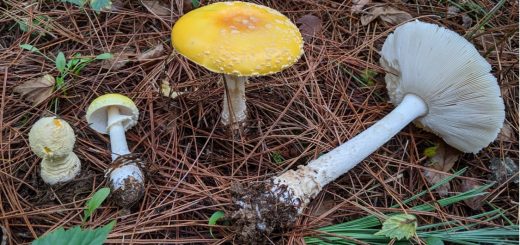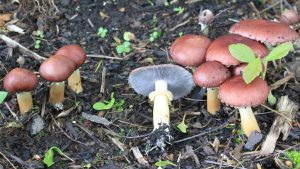#053: Slime Molds
On this first anniversary of Fungus Fact Friday, I would like to introduce a new topic which I have labeled, “That’s Not a Fungus!” Kingdom Fungi has gone through a lot of changes over the years. Many organisms that were once included in the kingdom have since been exiled. There are two reasons why I think these organisms are worth discussing in FFF. First, they were once studied by mycologists, in some cases contributing more to our understanding of fungi than the fungi themselves. Second, it is important to know what a fungus is as well as what a fungus is not. Slime molds are no longer considered fungi because really the only things those two groups have in common are a similar life cycle and “strange” fruiting bodies. Slime molds do not have cell walls and grow as neither hyphae nor yeast. They also engulf (phagocytose) their food before they digest it, while fungi digest their food before absorbing it.
The most commonly encountered slime mold is probably the Dog Vomit Slime Mold (Fuligo septica). You’ve probably seen it before: a yellow, lumpy, fuzzy smear oozing out of a patch of mulch. At first, it may look very much like a fungus (perhaps a young Phaeolus schweinitzii or Inonotus sp.), but if you watch it long enough you will notice a key difference: it moves. Ok, so this thing would lose in a race with a snail, but it clearly moves. In my photo album Mycology 101 there is a picture of the Dog Vomit Slime Mold fruiting about 10cm up the trunk of a healthy tree. A couple weeks ago I found one that had climbed roughly the same distance up a brick wall. That time there were a couple other masses in the surrounding mulch, one partially covering the leaves of a small plant. Clearly, the slime molds emerged from the mulch and oozed around to their final resting places. Fungi can’t do that. Although mushrooms may magically appear, they remain attached to the substrate in which the fungus lives.
So how do slime molds manage their locomotion? The answer is that they have a completely different cellular structure than fungi. Fungi produce stationary cells as hyphae or yeast and colonize new areas by growing bigger* (see FFF#003 for more). Slime molds, on the other hand, are cells that can move independently. There are two types of slime molds: plasmodial and cellular. Initially, the cells of plasmodial slime molds move around as individual, flagellated cells. These individual cells quickly fuse together to make a giant cell with multiple nuclei (called a plasmodium) which moves like a large amoeba. Some of these plasmodia are truly enormous cells, occasionally as large as a pizza! Cellular slime molds, on the other hand, mainly live as individual cells that move around using amoeboid motion. The individuals come together to form large, multicellular masses only when it is time to fruit. When nutrients run out, both types of slime mold produce fruiting bodies with sexual spores. These haploid spores are disseminated by the wind. When conditions are right, the spores germinate, find another cell of the same species, and fuse their nuclei with that cell to make a diploid cell. This completes sexual reproduction and the life cycle begins again. Slime molds are usually found in well-decayed plant material like old logs, forest litter, or mulch, where they feed on bacteria, fungi, and decaying matter. However, slime molds can be found in all sorts of places. I once saw a small slime mold that had climbed roughly 30cm up someone’s rubber boot to fruit. Recently, I found a small slime mold a meter or so up a holly tree on a leaf among sooty mold and scale bug debris. Many slime mold fruiting bodies are tiny, with stalks no thicker than a human hair. So keep your eyes open; you never know where you’ll find a slime mold!
Slime molds come in many different shapes and sizes. Although people are probably most familiar with the Dog Vomit Slime Mold, a majority of slime molds look nothing like that species. Slime mold fruiting bodies can be classified into three types: the sporangium, aethalium, and plasmodiocarp. The sporangium is the most complex and consists of a base which attaches it to a substrate, a long, thin stalk, and an apical mass that produces the spores. The aethalium is cushion-shaped and contains the spores. The plasmodiocarp is a branching structure, often formed on top of the main veins of the plasmodium. There are lots of variations on these basic structures, and many are quite intricate and beautiful. In addition to beautiful fruiting bodies, slime molds lay claim to numerous descriptive and almost poetic names. Here are a few examples (you may want to do an image search for these in order to get a sense of the diversity of the group): Chocolate Tube Slime Mold, Red Raspberry Slime Mold, Wolf’s Milk Slime Mold, and Pretzel Slime Mold.
Biologists have found many uses for slime molds. The plasmodium behaves similarly to cancer cells when cut and is easy to manipulate, so plasmodial slime molds have proven valuable models for how such cells behave. Plasmodia have also been used to study cytoplasmic streaming (the coordinated movement of cytoplasm from one part of the cell to another), which is involved in cell motility, growth, and division. Slime molds have also been investigated for their ability to form efficient networks. When placed on a map of a city or country with population centers represented by food, they will produce a network that mimics that area’s existing highway system. What it took humans decades to come up with, the slime molds can map out in just minutes. Understanding how this is done has the potential to help us design more efficient systems for the transportation of people, ideas, etc. Cellular slime molds are useful for studying cell-to-cell communication and group selection. Cell-to-cell communication is very important for the cellular slime mold. In order for the mass of cells to find the best place from which to fruit, the cells must be able to communicate effectively with one another. This is a relatively simple system that provides a model for how this is achieved in more complex organisms (like humans). Although group selection can and does happen in populations of larger organisms, it can be easily seen in cellular slime molds. For the most part, we think about natural selection acting upon individuals (i.e. an individual dies and its genes are removed from the population). However, natural selection acts on groups of individuals when cellular slime molds are in the process of fruiting. Many individuals with different genetic compositions come together and fruit as a single organism. During this time, natural selection acts upon the group of cells rather than on the individual cells. For example, not all individuals get to pass on their genes when fruiting. Some cells need to form the supporting structures like the stalk. These cells do not produce spores, yet group selection ensures that the supporting structures are maintained because they improve the fitness of the group as a whole.
Exactly where slime molds fall on the tree of life is still under investigation. Slime molds are currently placed in the kingdom Protista. Plasmodial slime molds comprise a monophyletic group, while cellular slime molds include two separate, monophyletic groups. These three groups are not necessarily closely related to one another and do not form a distinct clade. A fourth group, the Labyrinthulomycota, is sometimes included with the slime molds, but appear to be unrelated. For more information on the phylogeny of slime molds, see the links below and do your own research. Each site provides a different classification scheme based on how long ago it was written. Because of the rapidly changing phylogeny of the slime molds, Wikipedia might actually provide the most up-to-date placement information.
Finally, I feel that I need to say a word about “getting rid” of the Dog Vomit Slime Mold fruiting in your garden. The quick answer is: you can’t. Sure, you can pick it up and throw it in the trash if you feel it is too unsightly for your well-kept garden. However, do you really want to? Gardening is dirty, not sterile. Plants grow best in good soil, which is teeming with microorganisms (including slime molds). Really, you should be thanking the slime mold for being a part of the ecosystem that you’ve worked so hard to maintain.
* A few fungi have motile spores, but these are not the main body of the fungus.
See Further:
http://www.ucmp.berkeley.edu/protista/slimemolds.html
http://www.ruf.rice.edu/~bioslabs/studies/invertebrates/dicty.html
http://www.mushroomexpert.com/myxomycetes.html
http://botit.botany.wisc.edu/toms_fungi/june99.html
http://botit.botany.wisc.edu/toms_fungi/oct2003.html
http://waynesword.palomar.edu/slime1.htm








![#011: Characteristics of Kingdom Fungi [Archived]](https://www.fungusfactfriday.com/wp-content/themes/hueman/assets/front/img/thumb-small-empty.png)


really BORING
great article thanks, how would you suppose you would treat a human infected with slime mold?
Interesting question. I could not find any records of a slime mold infecting a human (since they eat bacteria, this is not surprising), so there is no set strategy. However, slime molds belong to the same lineage as Entamoeba histolytica, which causes the disease Amebiasis. These infections are treated with azoles, mycins, or diloxanide furoate (a drug specific for E. histolytica), so these groups of drugs would probably also work to combat a slime mold infection. Of course, none of these have been tested against slime molds in a clinical setting because slime molds don’t infect humans.
thanks for reply, but it seems they do and its a big problem, look into morgellons disease
Morgellons disease has a lot of controversy surrounding it, so there isn’t much good information available about it. Some published studies link the disease to Lyme Disease, but Lyme Disease is caused by a bacterium. A few websites link it to a slime mold but do not support that link with research.